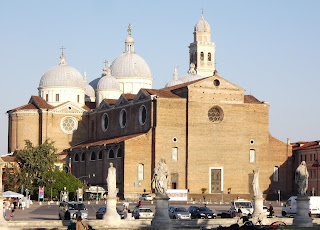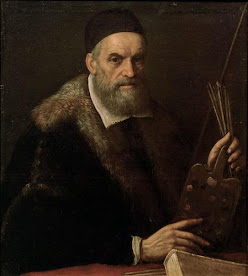The Basilica di Santa Giustina holds one of painter's greatest works
Jacopo Bassano, who died on 14 February 1592, painted altarpieces for many churches in Padua, Treviso, and Belluno.
 |
Bassano's painting of Santa Giustina
was executed in about 1560 |
Visitors to the Basilica di Santa Giustina, the large church in the southeastern corner of Prato della Valle in Padua, can see Bassano's
Santa Giustina enthroned with the saints Sebastian, Antonio Abate and Rocco, which was painted by him in around 1560 with the help of his son, Francesco.
It is considered one of his best works and also one of the most original examples of the Venetian Mannerist culture.
Bassano was born in about 1510 in Bassano del Grappa, a town about 50km (31 miles) north of Padua, and is said to have been christened Jacopo dal Ponte, although his statue in the town names him as Giacomo da Ponte. His father, Francesco il Vecchio, was already a successful painter in the town and had established a workshop that produced mostly religious works.
Jacopo became an apprentice in his father’s workshop while still a young boy. He made his way to Venice when he was about 20, where he studied under Bonifazio de Pitati, who was also known as Bonifazio Veronese.
While in Venice, he met famous artists, such as Titian and il Pordenone, and his work from this period shows Titian’s influence and demonstrates his lifelong appreciation of the great artist’s work. Jacopo Bassano’s earliest paintings also show his love of the brilliant colours used by Titian.
Bassano’s Supper at Emmaus (1538), originally commissioned for a church, uses rich luminous colours that distinguish the figures from their background. Unusually, he places Christ towards the back of the scene, allowing the figures around him to play a more significant part. He dresses them in 16th century clothes rather than in robes in the classical Roman tradition. He includes food on the table and there are a dog and a cat in the picture, showing he has drawn on contemporary life for his inspiration rather than just sticking to the stylistic conventions of his age.
 |
The Basilica di Santa Giustina is a former abbey
adjoining the wide Prato della Valle piazza |
After his father’s death in 1539, Jacopo Bassano returned to Bassano del Grappa and took over the running of the family workshop. He married a local woman, Elisabetta Merzari, in 1546.
His painting of The Last Supper in 1542 shows the influence on his work of Mannerism and indicates that he had seen the paintings of Durer and Raphael because his figures seem alive, with muscles and sinews, in the style of the two great artists.
After about 1550 he started experimenting with light and he was one of the first painters to paint a ‘nocturne’, a scene taking place at night time, which was to make his paintings even more highly valued. He also tended to place his subjects in a natural landscape with carefully painted trees and flowers.
His four sons, Leandro Bassano, Francesco Bassano the Younger, Giovanni Battista da Ponte and Girolamo da Ponte, all worked in his workshop and followed him closely in style and subject matter.
The Basilica of Santa Giustina, which is the ninth largest Christian church in the world, is at the corner of Prato della Valle where it is joined by Via Avazzano and Via Ferrari.
 |
A portrait of Jacopo Bassano by his
son, Girolamo da Ponte |
The church contains the remains of Santa Giustina, a devout young woman who was martyred in 304, and is also home to the tomb containing the body of St Luke the Evangelist, who was credited with writing the Gospel according to St Luke. Next door to the basilica there is a Benedictine monastery with frescoed cloisters and a famous library that can be visited by arrangement.
After Jacopo’s death in 1592, his sons produced numerous works in his style, making it difficult for art historians to establish which pictures were created by Jacopo Bassano himself and which were the work of his sons.
His work is considered unique because it incorporated diverse artistic influences. He is believed to have learnt from Durer, Parmigianino, Tintoretto and Raphael, even though he lived permanently in Bassano del Grappa, mainly by seeing their prints, of which he became an avid collector.
Bassano del Grappa, where Jacopo Bassano was born and died, and from which he got his professional name, lies at the foot of Monte Grappa in the province of Vicenza and is an easy day trip to make from Padua. The town is famous for inventing grappa, a spirit made from the grape skins and stalks left over from wine production, which is popular with Italians as an after dinner drink to aid digestion. A famous sight in the town is the Ponte degli Alpini, a bridge designed by Andrea Palladio.
Home











